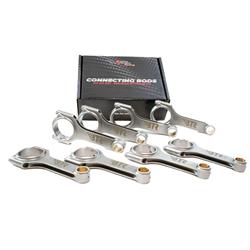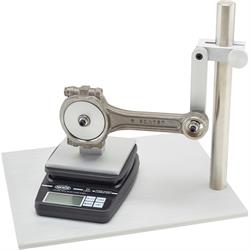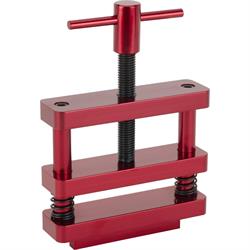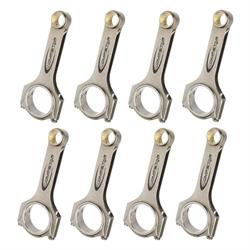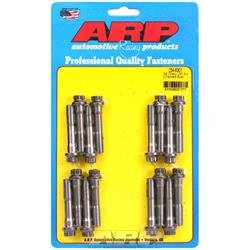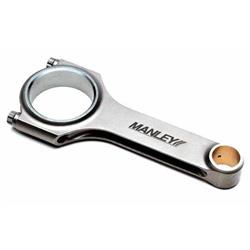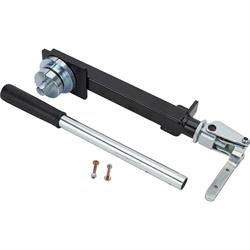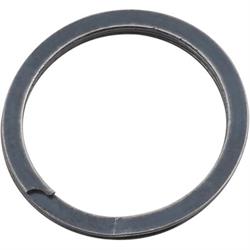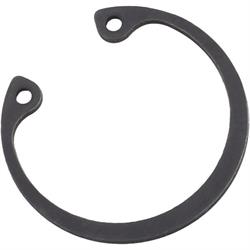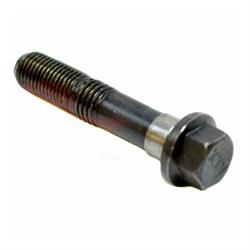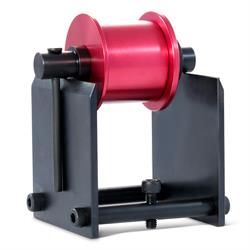Engine Builder’s Guide: H-Beam vs. I-Beam Rods Explained
The short block of any engine (outside of rotary engines, of course) is made up of four components: the engine block, crankshaft, pistons, and connecting rods. Connecting rods or “con rods,” are the intermediary between the crankshaft and the pistons. While the function is quite simple, the construction of connecting rods is not. There are many different styles of rods, depending on application and power level. Connecting rod failures are usually catastrophic, as a broken rod spinning around the block at 5,000 rpm is like a giant hammer. In other words, if you don’t want to add any windows to your engine block, you need to select the right connecting rods.
What is a Connecting Rod?
A connecting rod function is to connect the piston to the crank. There are two main types of rods, I-beam and H-beam. They are called this for the way the shaft between the crank journal (big end) and pin journal (small end) looks. I-beam rods look like a capital “I,” having two wide edges on the side of a wide center section. H-beam rods look like a steel beam, with a wide face and a thinner center bridge. While both are strong, there are some key differences between the two.
Connecting Rod Diagram | Assembly Explained
The anatomy of a connecting rod is the same regardless of the type of connecting rod. The big end bolts around the crank journal with a bearing between them. At the top of the rod is the piston wrist pin bore. The bore may be bushed with a bronze insert or raw steel, depending on the type of wrist pin used. Bushed ends are used with floating pins, whereas un-bushed ends are for press-fit pins.
H-Beam Rods vs I-Beam Connecting Rods Key Differences
H-beam rods are typically used for naturally aspirated applications under 1,000 hp. This style of rod was originally developed for WWII fighter planes after numerous rod failures from the heavy use of nitrous oxide. The H-beam rod is both lightweight and durable at the piston-end, which sees more stress in nitrous applications. It is easier to lighten an H-beam rod than an I-beam, making them better suited for high-revving applications. H-beam rods tend to be more affordable, as they are easier to machine as well. Best suited for high-rpm NA or nitrous applications, the H-beam rod tends to have a wider profile at the big end (crank side). If you are looking to replace a set of stock rods with high-performance aftermarket rods, the H-beam is an excellent choice.
I-beam rods are the most common style of rod. Most stock rods are I-beams, as these are easy to make and do not require as much machining in the manufacturing process. Where H-beams are light, I-beams tend to be heavier, as they are thicker in the middle section. The piston end is thinner, but the design of the “I” yields a gusset from the sides of the pin bore to the center section, providing more compression strength. At the big end, I-beams are narrower, providing more clearance for stroked applications. The I-beam design handles higher compression loads better, as the “I” can’t expand. Under heavy compression loads, the sides of an H-beam can actually bow out. Better suited for boosted engines, high-performance I-beam rods are the go-to rods for 1000+ hp engines.
Types of Connecting Rod Materials: Billet, Forged, & Cast
What are connecting rods made of? Beyond the design type, what really sets rods apart is the build material. There are three main categories of material used: cast, forged, and billet.
Cast rods are what most factory engines use. Cast rods are cheap to make and are very good for lower power ratings. Modern cast rods are powdered metal rods, which are made by filling the mold with powered steel and then pressurizing the metal under extremely high pressure and temperature. This process does not fully melt the steel, instead it is “sintered,” which makes them extraordinarily strong yet malleable enough to absorb substantial shock. An older truly cast rod is made by filling a mold with liquid steel and allowing it to cool, resulting in a simple part that is easy to produce quickly. Depending on the engine, cast rods can handle as much as 1,000 hp (GM 5.3L LS engines for example), however most cast rods are not good beyond 500hp.
Forged rods are the bread and butter of the high-performance engine industry. Capable of handling 4-digit power numbers, there are many options available. Forgings are made by heating a steel or aluminum billet to its forging temperature where the metal is malleable (like heavy clay) and then pressed into a forging die to force the billet into the rough shape of the rod. This is often done in several stages. The forging process aligns the molecular structure, reducing stress points and giving the metal a uniform grain, enhancing the overall strength. Once fully formed, the rod is then heat treated and then machined to its final form. This is a more labor-intensive process, making forged rods more expensive. Some OEM engines use forged rods, particularly heavy-duty and high-performance factory engines
Forged vs Cast Connecting Rods
Because every engine design is different, you may not need to upgrade the OEM rods for your application. As previously mentioned, GM LS-series engines use powdered metal rods, which are good for up to 1,000 hp. Does that mean they will last for years at that power level? No. Could they break at 600hp? Yes. So, when it comes down to it, if you are spending your own money, you must decide where it is best served. Some OEM cast connecting rods are not good beyond the factory power ratings, you must research your specific engine to make the right call.
Upgrading to forged rods requires more than just buying a set of rods and slapping them in. For the engine to run correctly, changing out the rods requires balancing the rotating assembly. This is done with a special machine, which spins the crank with a bob weight that equates that of the piston and rod, and the crank is adjusted by drilling (make lighter) or adding Mallory metal (make heavier) to complete the balancing process. If you do not do this, you run the very real risk of an imbalanced engine that can break itself from harmonic vibrations. You’ll find forged rods from brands such as BTR, SCAT Crankshafts, Manley, and Callies.
Billet vs Forged Connecting Rods
Billet rods are the pinnacle of connecting rod technology and tend to be reserved for race engines. These rods start out as a single piece of billet steel or aluminum, which is then machined to the size and shape, making these the most expensive type of rod. Billet connecting rods are ideal for custom and extreme performance applications. Forged connecting rods are extraordinarily strong, but billet rods are even stronger. If you are looking at 2,000 hp, billet rods are likely in your future.
H-beam VS I-Beam Connecting Rods
Are you confused yet? That’s OK because so is the entire high-performance engine industry. In reality, the build materials and overall design is far more important than I-beam or H-beam. You will find both styles in every kind of street or race engine build; even F1 engines use both styles. That said, most billet connecting rods are made in the I-beam style, so take that as you will.
What is a Connecting Rod Assembly and How Does it Work?
Once you have your rods (which you had balanced, right?), you must assemble them. While they are relatively simple, there are a few caveats that you should know. Most aftermarket rods use floating pins to connect the rod to the pistons. These use circlips or spiral locks on either side of the pin on the piston to keep them in place. Install these wrong, and you will have a bad day sometime in the near future. Press-fit pins require heating the small end of the rod to about 500 degrees, just hot enough for the rod eye to expand, allowing the pin to be pressed into the rod through the piston. These are much harder to remove, so you need to do it right the first time. A piston pin jig is the best way to do this safely and quickly. You can heat the rod in an oven, with a propane torch (less reliable), or preferably in a rod heater. It can also be helpful to have a connecting rod weighing fixture on hand.
Another especially important tip is to never replace rod bolts without having the rods checked for size and roundness. New bolts tend to have different clamping rates, and you can end up with a rod bore that is oval instead of round. This will cause poor bearing wear and premature failure of your engine. Additionally, most rods have a large chamfer and small chamfer on the big end. This is to accommodate crankshafts with rounded filets at the ends of the crank journal. The large chamfer faces the outside (rod to crank), and the small chamfer goes to the center (rod to rod). You do not want to get this wrong, as your assembly will be too tight to spin.

